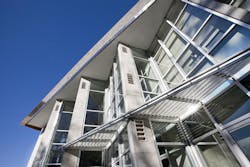Blue Ridge Parkway Destination Center Optimizes Energy Performance
Atlanta, GA-based Lord, Aeck & Sargent recently announced that in awarding LEED® (Leadership in Energy and Environmental Design) Gold certification to the Asheville, NC, Blue Ridge Parkway Destination Center in the category of new construction, the Washington, DC-based U.S. Green Building Council (USGBC) gave the project the maximum 10 points in the category of optimized energy performance, plus an additional point for exceeding the maximum (60 percent) energy savings tracked for this credit. The project tracked a 75-percent improvement in energy performance over a code-compliant base building.
"To the best of our knowledge, it's extremely rare for a project to achieve more than the maximum 10 points allowable in the USGBC's optimized energy performance category, but frankly, we're not surprised that our Blue Ridge Parkway project earned 11 points," says Jim Nicolow, AIA, LEED AP, director of sustainable development at Lord, Aeck & Sargent, which designed the Destination Center for the National Park Service.
"That's because, in addition to numerous energy conservation integrated design strategies such as hydronic radiant heated flooring and a high-efficiency HVAC system with an energy recovery wheel, our most innovative strategy was the use of high-tech computational fluid dynamics (CFD) modeling to analyze our use of low-tech passive solar Trombe walls," Nicolow continues.
Trombe walls use the sun to heat a small air space between a glass wall and a heavy-mass wall such as concrete. The trapped heat is then transferred into the building, either indirectly through the concrete or, as is the case with the Destination Center, directly through vents. To study the walls, Lord, Aeck & Sargent partnered with Pennsylvania State University's Applied Research Laboratory (ARL) to construct the CFD computer model to study the movement of fluid flow - air in this case - and heat transfer. The Destination Center's south façade features a row of 13 passive solar Trombe walls in a saw-tooth formation; the walls help to heat the building in the winter and cool it in the summer.
Ongoing Energy Performance Analysis
Vikram Sami, LEED AP, senior building performance analyst, explains that since construction of the Destination Center was completed in November 2007 Lord, Aeck & Sargent has been conducting an ongoing analysis in partnership with the Georgia Institute of Technology's College of Architecture to evaluate the building's energy performance and to compare it with Penn State's CFD analysis.
"While it's still too early to make any definitive assessments," Sami says, "the facility's optimized passive solar design, along with a mix of other strategies, is projected to reduce energy use by 75-percent over an ASHRAE 90.1-1999 base building. This reduction was achieved by integrating energy modeling into the design process, and using dynamic analysis tools like CFD to analyze the passive performance of the building.
In addition to the Trombe walls, other integrated energy optimization strategies utilized in the design of the Destination Center include:
•· An HVAC system that uses an energy recovery unit to transfer heat from air exhausted out of the building to air entering the building in the winter. In the summer, the energy recovery unit pulls moisture out of the air that enters the building.
•· Appropriate orientation and external overhangs and shading devices to allow sunlight in the building in winter while blocking it in the summer to prevent overheating of the walls.
•· Radiant heated flooring, which reduces both heating and fan loads.
•· Increased roof and wall insulation, and a 10,000-square-foot green roof, 100 percent of which is planted with native, drought tolerant plants to reduce heat transfer through the building skin.
•· Daylight harvesting coupled with efficient lighting design to reduce lighting loads by 78 percent. Lights are controlled with photo and occupancy sensors that turn off the lights when the daylight is sufficient, or when the Destination Center is unoccupied.
•· High performance glazing utilizing thermally broken aluminum frames.
•· Natural ventilation to reduce the building's cooling load in the swing seasons.
•· Operable windows in the facility's offices and exhibit hall.
•· Ceiling fans, which move stratified warm air back down from high ceiling spaces.
In all, the Blue Ridge Parkway Destination Center garnered 44 points to achieve its LEED Gold certification from the USGBC. The points were awarded in all six major environmental categories of review, including: Sustainable Sites, Water Efficiency, Energy and Atmosphere, Materials and Resources, Indoor Environmental Quality, and Innovation and Design Process.
The Project Team
The Blue Ridge Parkway Destination Center project team included:
•· Blue Ridge Parkway, owner, the Southeast Region of the National Park Service, and the Denver Service Center, the NPS' planning, design and construction management office.
•· Lord, Aeck & Sargent, Inc. (Atlanta), architect.
•· Van Sickle & Rolleri Ltd. (Medford, N.J.), exhibit designer.
•· The Jaeger Co. (Athens, Ga.), landscape architect.
•· Rocky Mountain Institute Built Environment Team (formerly the ENSAR Group) (Boulder, Colo.), daylight modeling.
•· Newcomb & Boyd (Atlanta), MEP/FP engineer, commissioning, communications, and security.
•· Palmer Engineering Co., Inc. (Tucker, Ga.), structural engineer.
•· Long Engineering, Inc. (Atlanta), civil engineer.
•· Waveguide Consulting (Atlanta), theater AV and acoustical consultant.
•· Applied Research Laboratory at The Pennsylvania State University (State College, Penn.), computational fluid dynamic modeling.
•· Perry Bartsch Jr. Construction Co. (Asheville, N.C.), general contractor.
